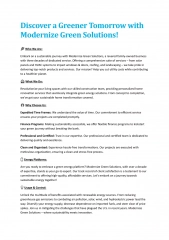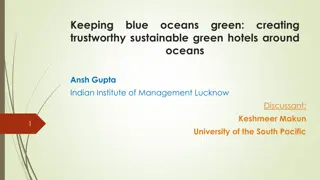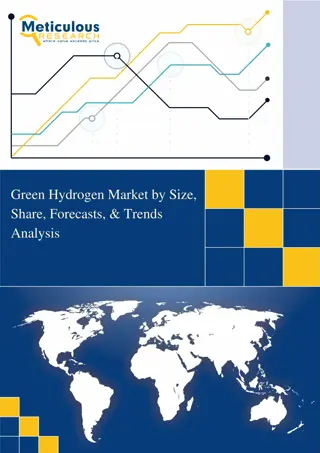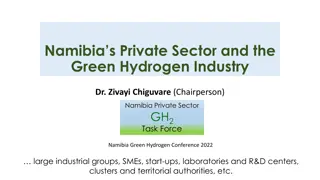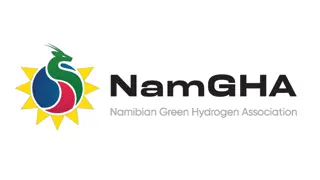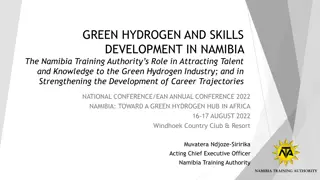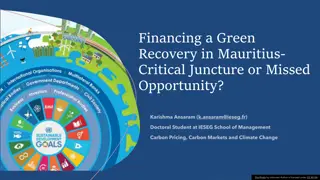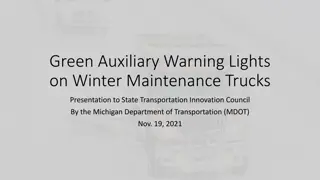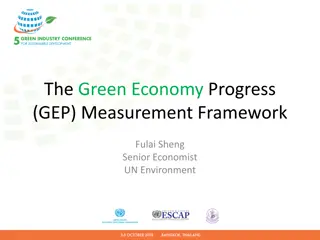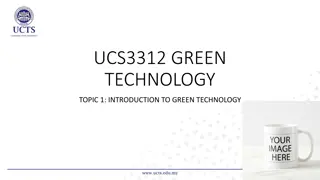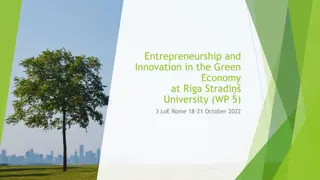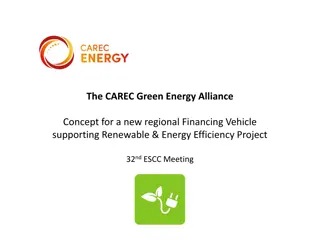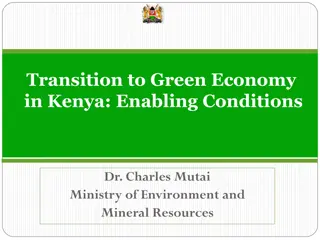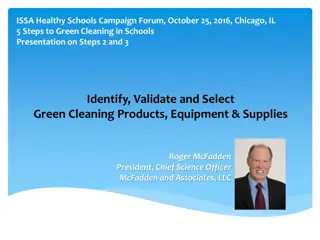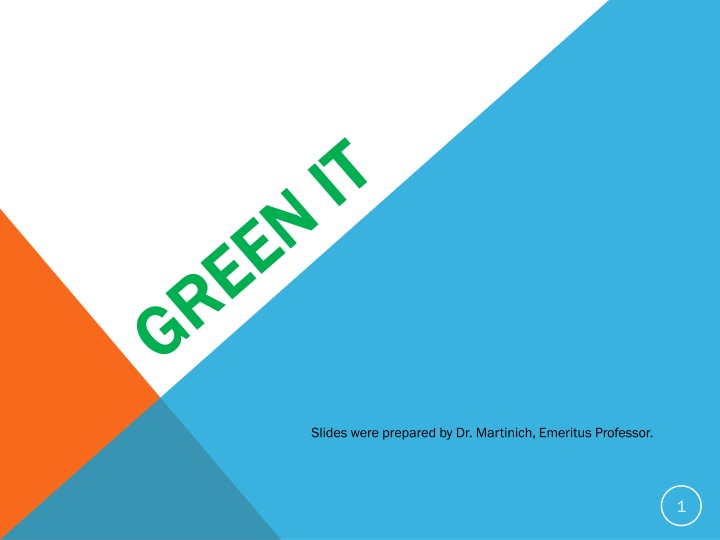
Green IT and Its Components
Explore the concept of Green IT, its benefits, and components like greening of IT and greening by IT. Learn how Green IT focuses on reducing environmental impacts while also providing cost-saving opportunities and promoting sustainability.
Download Presentation

Please find below an Image/Link to download the presentation.
The content on the website is provided AS IS for your information and personal use only. It may not be sold, licensed, or shared on other websites without obtaining consent from the author. If you encounter any issues during the download, it is possible that the publisher has removed the file from their server.
You are allowed to download the files provided on this website for personal or commercial use, subject to the condition that they are used lawfully. All files are the property of their respective owners.
The content on the website is provided AS IS for your information and personal use only. It may not be sold, licensed, or shared on other websites without obtaining consent from the author.
E N D
Presentation Transcript
Slides were prepared by Dr. Martinich, Emeritus Professor. 1
WHERE ARE WE GOING? WHERE ARE WE GOING? What do we mean by Green IT? How Can I/we achieve Green IT? Specific simple actions we can take to make IT green 2
WHAT IS GREEN IT? WHAT IS GREEN IT? Focus is to reduce harmful environmental impacts of organizations and people Help to create a more sustainable world That s nice, but what s in it for me? My job is to make IT systems work. Trying to make them green is just an extra burden Is this true? Is this true? 3
Green IT Green IT provides an opportunity to: Reduce costs Increase revenues AND AND reduce environmental impacts 4
Green IT Green IT has three components has three components Greening OF OF IT Greening BY BY IT USING IT to promote promote green initiatives and behavior 5
GREENING GREENING OF OF IT IT efficient and effective design, manufacture, operation, use, and disposal of computer and communication systems (including hardware, software, storage, and networks) aiming for minimal or zero impact on the environment. (Murugesan, 2013) 6
How? How? Energy efficiency Using sustainable energy Using fewer material resources Using less harmful materials Promoting and facilitating reuse, repair, and recycling of IT equipment Payoff? Payoff? 7
GREENING BY BY IT using IT to support, assist, and leverage applications and activities in several other domains and industry sectors to reduce energy and resource consumption and carbon footprint. (Murugesan, 2013) 8
HOW? Enable dematerialization (replace physical goods with digital goods, online meetings) Re-engineer and optimize business operations within an entire supply chain (e.g., better reverse logistics) Make buildings, operations, vehicles, etc. more efficient Provide platforms for environmental management, emissions and used resource trading Energy and waste auditing and reporting Help environmental decision making: DSS, KM, etc. 9
USING IT TO PROMOTE GREEN INITIATIVES/BEHAVIOR Social media (e.g., promote energy efficiency or recycling within an organization or community) Using IT to promote green initiatives/behavior Green electronic games Using IT to promote green initiatives/behavior Interactive visualization Using IT to promote green initiatives/behavior 10
FOCUS TODAY: GREENING FOCUS TODAY: GREENING OF OF IT IT Suppose you were put in charge of IT operations, and instructed to make IT operations greener What is the first thing you would do? Why? What are the next two things you would do? Why? 11
LEARNING TO SEE LEARNING TO SEE The biggest opportunity to save money is to look at where you re spending money. -- from consultant in health care/insurance industry! Audit your operations Audit your operations What is the purpose? Where and how much money you are spending/wasting How and how much you are impacting the environment 12
Type(s) of audit? Type(s) of audit? Energy Audit Waste/Material Audit 13
ENERGY AUDIT ENERGY AUDIT Definition: How Definition: How much energy (mainly electricity) is much energy (mainly electricity) is being used for IT purposes? being used for IT purposes? Metered data, but IT operations often not separately metered/sub-metered (unless dedicated facility) Electric bill data (and any sub-meter data) still useful and important to understand energy use and potential cost savings Good to know electricity tariff structure and use patterns (peak load, time of use, seasonality charges) 14
Where and how is it being used? Walk the facility and identify all uses of energy/electricity related to IT operations Servers Routers Computers and Monitors Tele-video and other telecommunications equipment Printers and other peripheral equipment HVAC and fans for IT equipment and facilities Lighting for IT activities 15
Determine floor space used (for efficiency and bench- marking purposes) Determine the hours of operation for facility and equipment Determine staffing schedule of operations Compute energy efficiency metrics Ex: For a data center => Power usage effectiveness (PUE) PUE = (Total Facility Energy/IT Equipment Energy) Want value close to 1.0, but many centers > 2 or 3 16
IT ENERGY IT ENERGY Why should we go through all this effort? Is it really that much of a (controllable) cost? IT is a clean business; does it really have that much of an environmental impact? YES and YES YES and YES 17
SOME IT ENERGY FACTS For a typical office operation, more than 60% of the electricity used is for computers and monitors Electricity used to be a small cost of data centers; now it makes up 40-50% of operating costs, and over the life of a server the cost of electricity may be twice the capital cost of the server itself. 18
As much as 30% of a typical small office-based organization s electricity bill may be due to powering and cooling servers running around the clock even when performing little or no work. Only 5-15% of data center electricity is for productive purposes (actual processing) The rest is for cooling the room and servers and to keep idle machines on waiting for work 19
Worldwide, data centers require more than 40 gigawatts of power load 2-3% of global electricity In 2013 data centers consumed 91 billion kWh in the U.S. (enough to power every household in NYC) This is just data centers not all IT equipment 20
A single large data center can use as much power as a mid-size city Facebook DC in Altoona, IA uses 140 mW!!!! A typical 500 square meter data center (small to medium size) consumes 27,000 kWh/day (the use of about 1000 houses) 21
Many/most IT operations are very energy inefficient. Misaligned incentives: Lease structure: Utilities are free IT doesn t pay for its electricity use (or waste disposal, or many other resources) Lack of knowledge Green IT is usually not part of IT training/education 22
POTENTIAL COST SAVINGS POTENTIAL COST SAVINGS U.S. organizations squander $2.8 billion/yr to power unused machines (PCs). Many organizations report millions of dollars of savings per year (individually) from simple changes, such as virtualization, low power mode usage, turning off machines, more efficient programs, and opening the doors and windows! 23
HOW TO BE HOW TO BE GREEN AND GREEN GREEN AND GREEN Start with the simple and cheap Start with the simple and cheap stuff stuff Use power management software/controls (sleep mode) Turn off computers/equipment when not in use Turn off the lights Use computer virtualization Buy/use energy-efficient equipment Don t over-cool server rooms Use ventilation and natural cooling of server rooms 24
USE POWER MANAGEMENT SOFTWARE/CONTROLS Powers down equipment to low-energy state when not in use Individual devices Desktop PC: 40-60 watts (much better than old days ) LCD monitors: 15-30 watts In sleep mode computers and monitors use 1-5 watts Note: When a screen saver is running the monitor and computer are NOT in sleep mode! They are using normal power. 25
EXAMPLE PC and LCD monitor on 8000 hr/yr => 8000 hr/yr x 75 watts = 600 kWh/yr At $0.10/kWh => $60/yr; at $0.15/kWh => $90/yr If PC and monitor go to sleep mode 5000 hr/yr => 5000 hr/yr x 70 watts (reduction) = 350 kWh/yr saved At $0.10/kWh => $35/yr saved; at $0.15 kWh/yr => $52/yr saved 26
EXAMPLES Iowa State U. Installed energy-saving software on 500 computers at a cost of $3000/yr, but projected to save $50,000 a year in energy costs Partners HealthCare in Boston Idle computers go to standby mode: saved 5.5 million kWh/yr in direct energy and $1.4 million/yr (saves on cooling also) with minimal initial cost UW OshKosh 2900 PCs; power mgt. controls turned on (zero cost except labor). Annual savings of $76,500. 27
But computers cannot receive software updates or be accessed remotely (VPN) if they are in sleep mode No longer true Cheap/free software exists to wake computers from sleep mode remotely At a minimum, monitors don t need to be on 28
BETTER YET: TURN OFF EQUIPMENT WHEN NOT NEEDED BETTER YET: TURN OFF EQUIPMENT WHEN NOT NEEDED Reduces energy use of PC/monitor. Use power strips: turns off peripheries (modems, printers, speakers, etc.) at the same time Does NOT harm equipment Microsoft now considers leaving computers on when not in use to NOT be best practices simply for security reasons 29
TURN OFF THE LIGHTS! EVERYWHERE TURN OFF THE LIGHTS! EVERYWHERE WHEN NOT NEEDED WHEN NOT NEEDED Example 1: Dual level lighting, office Three three-light fixtures in my office Two switches control 4/5 28-watt fluorescent tubes If 5-tube switch turned off just 4 hours/day, 5 days/wk => 1040 hr/yr x 140 watts = 145.6 kWh/yr saved => That s $14.56/yr PER OFFICE per year 30
Savings are even larger because savings likely to occur during peak load hours (reduces peak demand and peak usage charges), and it extends the life of the lights, reducing maintenance costs 31
EXAMPLE 2 Dual level lighting, restroom Three four-tube fluorescent fixtures (28 watts per tube) and one LED safety light (can t be turned off by public) If fluorescent lights turned off just 8 hr/day (e.g., over night) and off 16 hr/day on weekends => 3744 hr/yr x 336 watts = 1258 kWh/yr saved or $125.80 /yr per restroom FREE FREE MONEY! MONEY! 32
SERVERS DONT NEED LIGHTS 1000 sf server room typically has 30+ fluorescent lights (28-32 watts each) To light the room 24/7 => 840 watts x 8760 hr/yr = 7358.4 kWh/y = $735.84/yr in electricity Potential savings is 50-99% of this This also reduces cooling load 33
USE COMPUTER VIRTUALIZATION USE COMPUTER VIRTUALIZATION Uses one computer/server to do the work of several Eliminates the costs of buying and operating extra computers and reduces energy costs dramatically Microsoft used virtualization to reduce server cost at one facility by over $1.5 million annually BMC Software eliminated 2000 servers using virtualization saved $10 million over 2 years, including $500,000/yr in electricity 34
BUY/USE ENERGY BUY/USE ENERGY- -EFFICIENT EQUIPMENT EFFICIENT EQUIPMENT Use laptops and tablets when convenient Laptop: 15-45 watts Tablet: 10-40 watts Large variation in energy-efficiency of similar equipment Include electricity use/cost in your purchase decision Newer equipment may be much more energy-efficient; energy savings could pay for upgrade 35
DONT OVERCOOL SERVER ROOMS DON T OVERCOOL SERVER ROOMS Not like the old days Newer servers can operate fine at higher temperatures Every one degree increase in thermostat setting saves 2-3% on electricity use 36
USE OUTSIDE AIR/VENTILATION FOR COOLING USE OUTSIDE AIR/VENTILATION FOR COOLING WHEN POSSIBLE WHEN POSSIBLE Yahoo! did this and reduced energy use by 60% Can be very cost effective (even in Arizona), but requires study and planning Issues Timing (e.g., super cooling at night when air is cold) Humidity 37
FACILITY DESIGN ACTIONS FACILITY DESIGN ACTIONS Bury data centers in the ground Easier to cool; uses natural cooling of ground Design HVAC to maximize use of ventilation An Intel study estimated that air cooling can cut the cost of a 10 mW data center by $3 million Locate in cold climates or by cold water Iceland, Scandinavian countries, UP, Maine, Washington But can work in hot, dry climates as well 38
Normal building design features (shading, windows, insulation, white roof, etc.) Shading is very effective White roofs usually good for data centers because they are single floor 39
DESIGN/LAYOUT DESIGN/LAYOUT Basic design principles can save a lot of energy Facebook now designs its on DC s and has cut energy use down to 1/3 of normal DCs Simplify the servers Strip out unnecessary components and housings Expose mother boards for better cooling Arrange racks to isolate hot and cool air to make it easier to cool and recover heat 40
RECOVER HEAT FOR REUSE Pella Windows vents hot air to the ceiling and then uses it elsewhere in the building or vents it outside (in summer) also reduces AC load 41
GET RID OF EQUIPMENT THAT IS NOT BEING USED Comatose servers, printers, etc.: plugged in Comatose servers, printers, etc.: plugged in and using energy, but doing little or no work and using energy, but doing little or no work Study of LexisNexis Atlanta DC More than half of servers were comatose Nearly of servers were using less than 10% of their computational ability Sun Microsystems instituted a bring out your dead program and got rid of 4000 servers 42
SOFTWARE SOFTWARE More efficient software design How software is programmed affects energy efficiency Fewer operational steps More efficient steps Less memory allocated for steps 43
eBay: by using the DSE dashboard, some of our software engineers saw that by slightly decreasing the memory allocated for an application in a pool of servers, they could remove 400 servers from the pool This insight helped us eliminate nearly a megawatt of power consumption and avoid spending more than $2 million to refresh the servers. This simple software tweak helped us lower power consumption, decrease costs and increase system performance, ultimately increasing our revenue per transaction. 44
WASTE/RESOURCE REDUCTION WASTE/RESOURCE REDUCTION Waste Audit Waste Audit How much waste is being generated? What is in the waste stream? What happens to the materials in the waste stream? How much is the waste stream costing us? 45
Few people know how much they are spending on waste disposal or how their costs are determined Potential to save thousands of dollars a year simply by better matching waste collection and recycling services (number and size of dumpsters and frequency of collection) to match the waste stream 46
WASTE AUDIT => WASTE STREAM ANALYSIS How do we reduce, reuse, recycle our wastes? Simple actions with little cost 47
PAPER PAPER Default double-sided printing Users pay for printing (internalize costs) Publicize/report paper use of department/unit Recycle used paper Recycled office paper is valuable Recent research Pair up large recycling container with small trash container 48
PRINTER CARTRIDGES PRINTER CARTRIDGES Recycle (worth a few dollars) Buy re-manufactured/re-filled cartridges Remind/train users to minimize white on dark or shaded printing When font style not important, use toner-efficient fonts 49
HARDWARE/EQUIPMENT HARDWARE/EQUIPMENT Try to buy energy-efficient equipment Encourage and support manufacturers that design their products to be truly green Long life Easy to repair Easy to recycle Minimize use of haz/toxic materials 50

